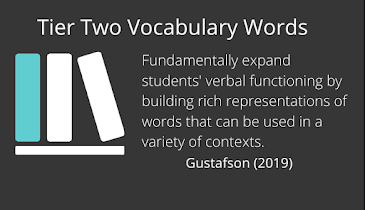Learners are empowered when they can read, write, think, and speak intelligently about a subject. Engagement with academic vocabulary helps deepen their understanding of your content.
Basics of Vocabulary Instruction
How can you embed a focus on academic vocabulary into your daily practice? Let's start with some basic reminders about academic vocabulary.
This Tier Two Word List is a great place to start, and any Marzano Vocabulary instruction book will have extensive lists of Tier Three words (Marzano, Pickering, 2005). Ideally, teachers, schools, and districts work together to choose the Tier 2 words they want to target.
Empower All Learners
All students thrive when they can access the necessary vocabulary associated with a topic, so imagine how significant this is for supporting our ELLs and learners with Dyslexia, IEPs, or general reading and comprehension deficits. The three phases of teaching vocabulary for language learners are Activate, Connect, and Affirm. We can build relationships and access prior knowledge in the "Activate" phase. In the "Connect" phase teachers embed sociocultural, linguistic, cognitive, and academic activities for students (Herrera, et al 2012). See below for further explanations.
Engage Students in Discourse
Students need to talk to process their learning, and academic vocabulary serves as specific success criteria for group discussion. Include academic vocabulary as an element on a discussion rubric to emphasize the value and expectation that students engage in discourse using the terminology associated with the content area. It really does matter if they say "hypotenuse" instead of "that line thingy."
Roots and Affixes and Morphemes, Oh My!
Take a few extra minutes to draw attention to word parts, and provide students multiple opportunities to hear, see, speak, and process the words. This focus on morphemes, including root words, prefixes and suffixes, can make all the difference in supporting comprehension. More learning and additional resources are coming as we dive back into Dyslexia training later this month.
Tools for Reinforcing Academic Vocabulary
Vocabulary notebooks, posters, word walls, sound walls, digital one-pagers, and games are all ways to reinforce academic vocabulary. As a general rule, focus on the following when instructing academic vocabulary:
- provide an image
- describe features
- provide a non-example
- use various contexts
To engage students in cognitive activities related to words, consider activities using compare/ contrast, word analysis, word sorts, true/false, and word games. Flash card programs like Quizlet offer a way for students to study basic definitions and even create their own study sets with images.
Want to learn more?
Join us next Wednesday, February 10th for our first after school PD session in which we'll investigate more specific tools and classroom practices to support effective vocabulary instruction. Meet in the library 3:50-4:30.







Comments
Post a Comment